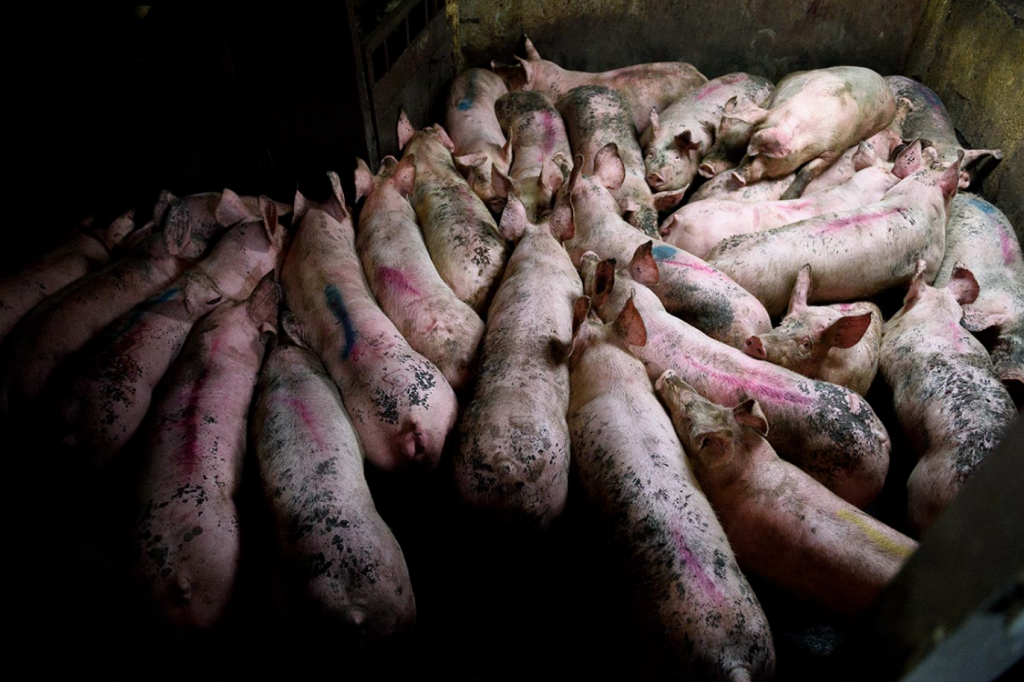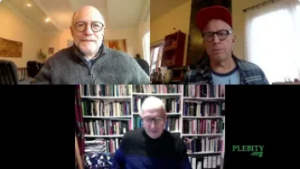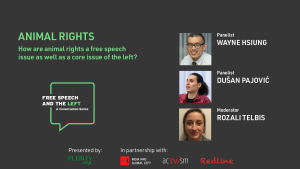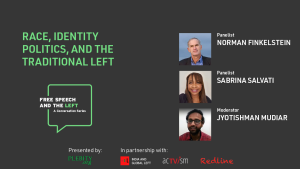Remembering Regan Russell
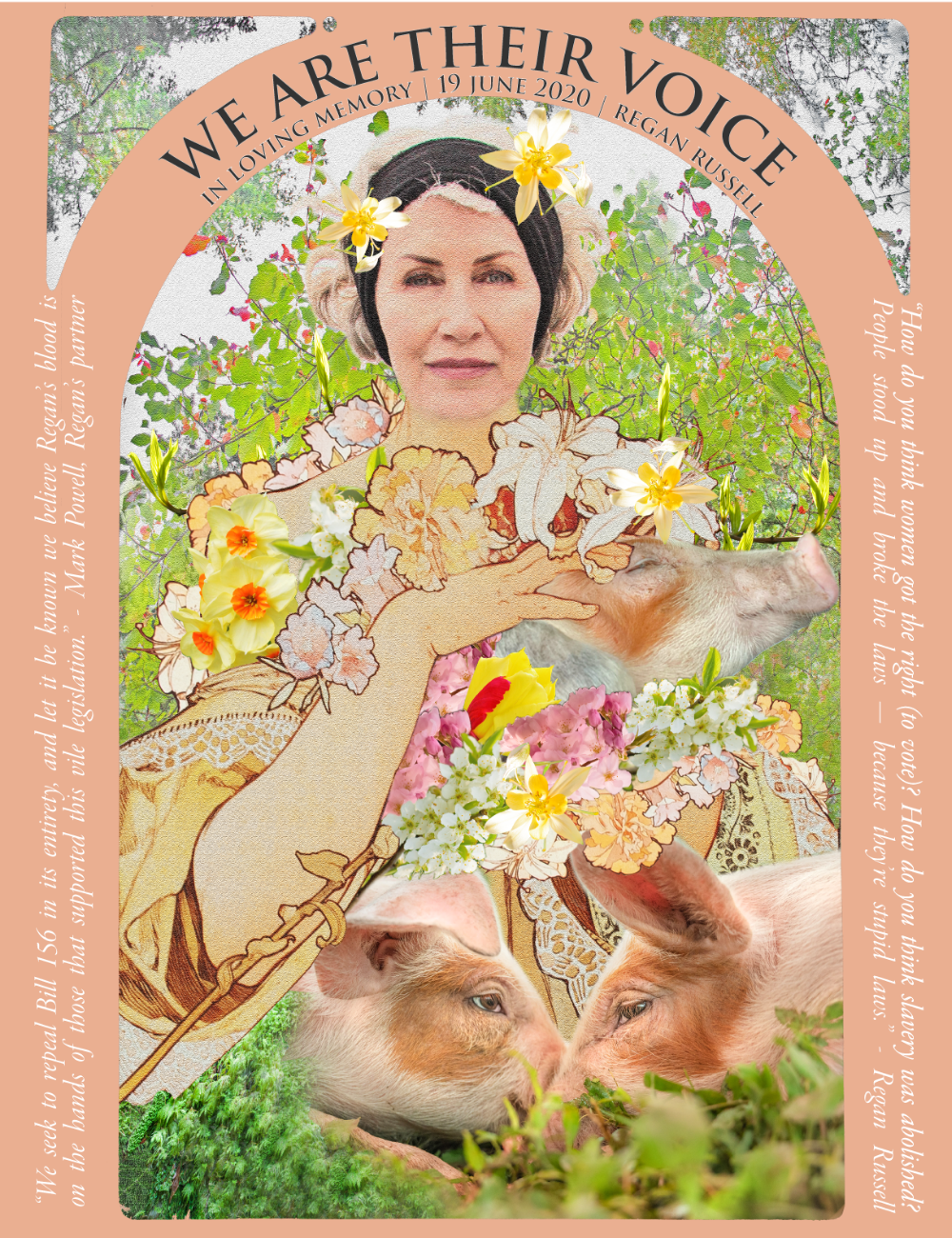
We Are Their Voice – artwork by Nicolay Bastos. Posted with permission from artist.
“We’ve been sold a bill of goods our entire lives – me, my parents’ generation. It is shocking, absolutely shocking, the lack of regard for the feelings of our fellow earthlings.” – Regan Russell
For well over a year, all eyes have been on the pandemic. While we have been singularly focused on the pandemic, another global tragedy has been taking place, though this tragedy has been happening for many years, its existence well-known, but conveniently ignored. It’s all around us, and has been normalized to such a point where any mention of it is met with denial, justification, ostracization, and anger – not anger on behalf of those suffering, but anger towards the messenger who is making the suffering known.
While it seems long ago now, for a brief period of time, the pandemic illuminated this tragedy, and it seemed that we might finally get it. No such thing happened. The tragedy was too uncomfortable to confront, let alone acknowledge. And so this tragedy was categorically dismissed, shoved into a box, and hidden away – but not without a warning that anyone who dares speak about it would run the risk of being labeled ‘—ist’ or phobic (as was the case amid the pandemic).
The tragedy I’m describing is the animal agriculture industry.
While most remain firmly in denial, there are some people actively breaking through the walls of silence and exposing the horrors of this sanctioned industry.
One Voice, Silenced
On June 19, 2020, on one of the hottest days of the year, Regan Russell positioned herself outside Fearmans Pork Inc. slaughterhouse in Burlington, Ontario, alongside six other activists.
Russell, an animal rights advocate since 1979, had been protesting outside the slaughterhouse for years, giving water and saying goodbye to pigs in transport trucks before they are killed and packaged for human consumption. On this day, Regan was not just there to bear witness, but also to oppose Ontario’s ag gag bill that had passed two days prior.
At this location, truckers had a well-established, though sometimes tenuous, agreement with the activists: they would give activists a few minutes to give pigs water, a kind touch, capture footage, and say goodbye. But on this day, one truck driver deviated from the script.
This particular driver sat parked in the traffic lane for multiple light cycles for about four minutes. (Some of the footage was recorded and released in a documentary). The driver then abruptly made a right turn from the left-hand lane, and with Russell in full view, he hit her and dragged her body the length of his 50-foot truck.
The driver struck Regan while she was standing at the crosswalk, near the entrance of the slaughterhouse, holding a one gallon water bottle with a hose attached, ready to give water to the pigs. The driver only stopped because a security guard was screaming at him.
Some eyewitnesses say the driver had every intention of killing Russell, others say he wanted to scare her, meanwhile others insist he did not even see her.
The driver never got out of the truck.
The Crate
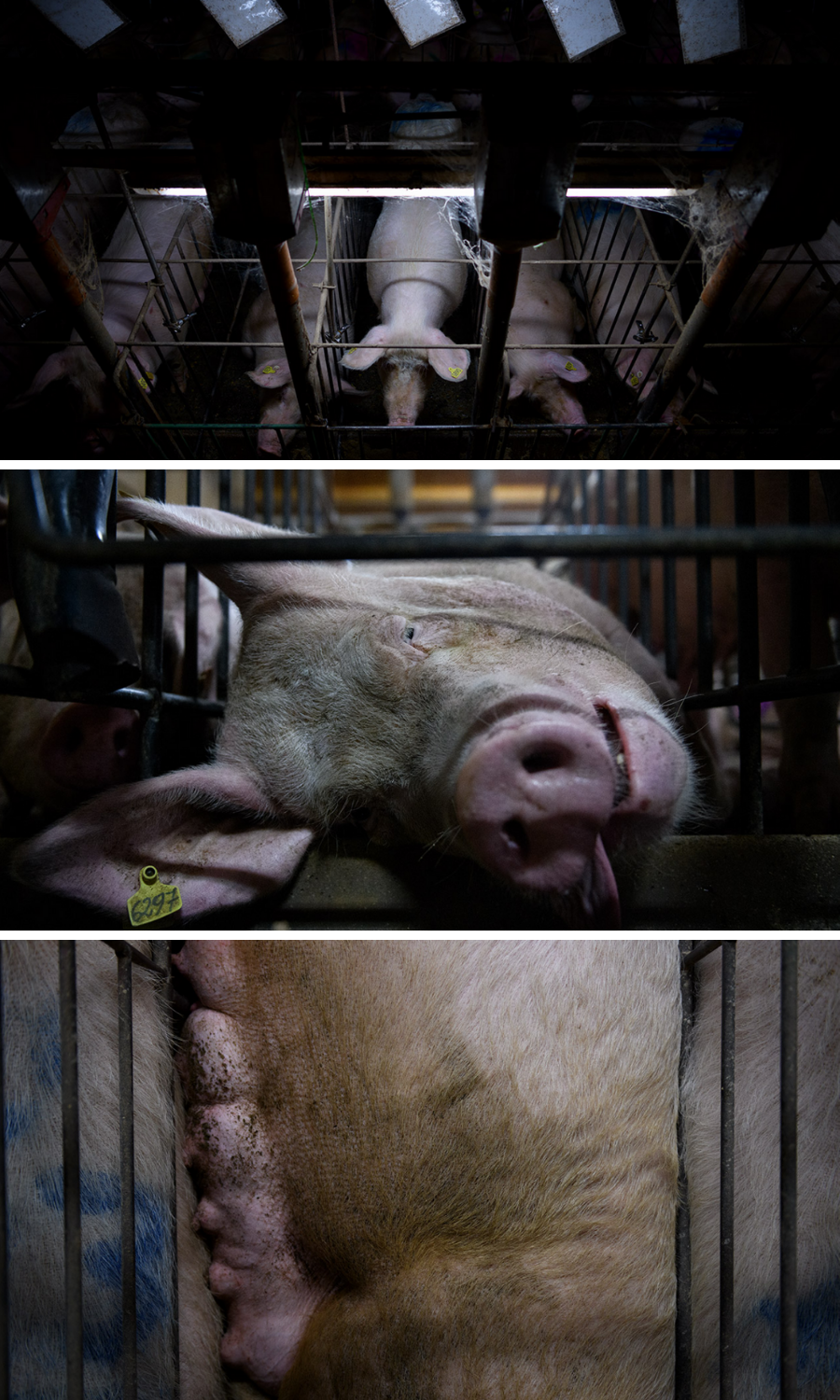
Aitor Garmendia / Tras los Muros
When we talk about animal agriculture, conversations typically center around the animals’ final destination: the slaughterhouse. But animal suffering doesn’t start in the confines of a slaughterhouse.
For piglets, it begins in a 2’ x 7’ farrowing crate – a metal enclosure that is barely bigger than the sow, who is also trapped in the crate, unable to stand, or turn around. The sow’s piglets stay with her for only a few weeks, until the piglets are forcibly taken away and moved to a crammed pen. The sows are then artificially re-impregnated just days later, to endure this painful process all over again.
After giving birth, the sow’s muscles considerably weaken, to the point where she’s often not able to stand at all. She has no bedding materials, just the concrete piled high with her own excrement. Pressure sores and infections will develop. Sometimes paralysis, too, which prevents the sow from reaching her water and food. For the sow, the crate is the last place she will spend her remaining years. She will endure this cycle of abuse a few more times, before she is killed and dumped on site, or sent to the slaughter.
Meanwhile, piglets that survive the crate are then transferred to crowded, artificial pens, where they are unable to express their natural behaviours. This extreme psychological and physical abuse often leads to cannibalism. Cannibalism is so common among pigs that workers now routinely, and without anesthesia, cut the tails and teeth of piglets when they are only a few days old. At a UK farm classed as ‘high quality,’ it was found that pigs were eating each other alive. This case, while brutal, is not uncommon for the industry.
Piglets deemed ‘unviable’ are often killed by blunt force. Other piglets that don’t make it to the pen die from disease, starvation, or by being accidentally crushed by their mothers who have no room to move in the crate. About five to six months later, the surviving pigs are shipped onto a truck, to be sent to the slaughter.
The Transport
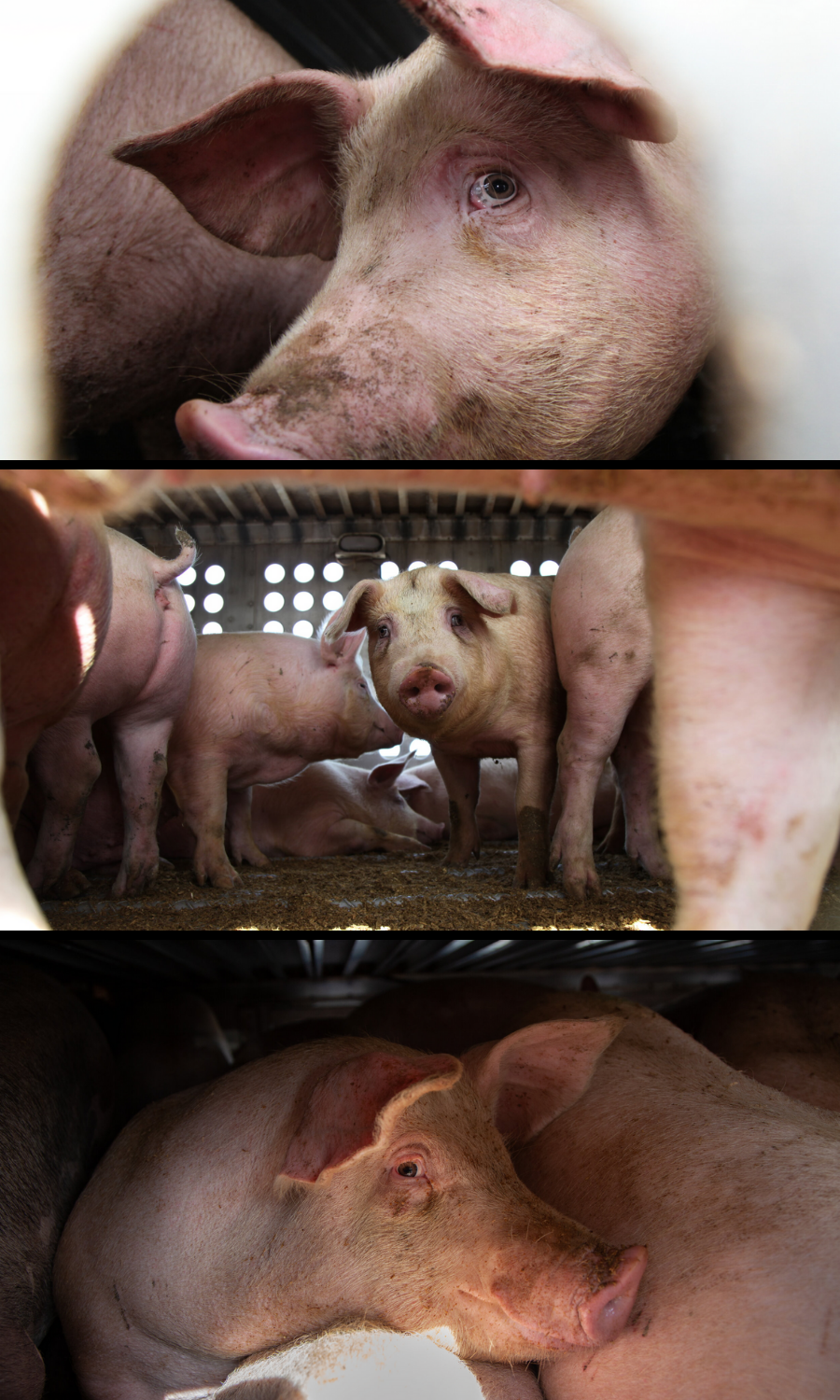
Pigs in transport truck outside slaughterhouse in Burlington, Ontario, Louise Jorgensen, Animal Sentience Project
From the day they are born, farm animals already come with an expiration date. Pigs typically live for an average of 10-15 years, but factory farmed pigs are killed after just six months. Once the pigs are ready for transport, workers may beat them, or stick electric prods into their rectums so they comply. Once on the truck, the pigs are hungry, exhausted, and disoriented, often going without food or water for up to 36 hours (the industry euphemistically calls this a ‘fasting period’ to prevent contamination). They are constantly inhaling ammonia fumes, diesel exhaust, excrement, and the smells of other sick or dead pigs. One transporter said that pigs “are packed in so tight, their guts actually pop out their butts – a little softball of guts actually comes out.”
Many pigs die on the way to the slaughter. In the winter, some pigs freeze to the sides of the unheated trucks; in the summer, pigs are at higher risk of heat exhaustion as they don’t have sweat glands. They may also suffer from dehydration, heart attacks, infections, and other illnesses. Once they arrive at the slaughterhouse, the pigs are so desperate to escape – but most are unable to walk, and they will collapse under the prolonged abuse they have endured in their tragically short lives.
According to industry reports, in the U.S. alone, 726,000 pigs, nearly 4 million broiler chickens, and 29,000 cattle die in transport every year – the industry calls this ‘dead on arrival’ or DOA. Dying or sick animals are labeled ‘compromised’ or ‘condemned.’
The Slaughterhouse
The final destination for pigs that survive transport is the slaughterhouse. Once the pigs are unloaded into the slaughterhouse, they are held in ‘lairage,’ an enclosed pen where they rest for a period of 3 to 24 hours before they are slaughtered. The reason for this is it allows for pigs to calm down so the quality of their meat isn’t ‘compromised’ (of course this is done in the interest of humans, not the pigs). During this holding period, pigs are once again crammed into artificial, concrete pens without food and little water.
Come slaughter time, the pigs are forcefully hurried through a narrow chute, where they are then stunned.
According to the world’s largest pork producers, the most reliable way of stunning a pig is gassing by carbon dioxide – and yes, this includes pigs that are from happy ‘free range’ farms. The industry boasts that this method of stunning is the most ‘humane,’ deceptively leading consumers to believe that pigs simply drift peacefully to sleep forever, but this could not be further from the truth.
Once in the gas chamber, a high concentration of carbon dioxide is released and quickly penetrates the pigs’ eyes, nostrils, mouths, and lungs. Unable to escape, the distressed pigs thrash at the sides of the chamber, gasping for air, and writhing in pain. This torturous scene often goes on for at least 60 seconds. In a blog post, CEO of Compassion in World Farming, Philip Lymbery, describes the agonizing practice, “The gas acidifies eyes, nostrils, mouths, and lungs meaning the animals feel like they are burning from the inside out.” Sometimes the CO2 fails to render the pigs unconscious, sometimes they choke, other times they may lose control of their limbs, though they are still awake. If that method fails, stun method #2 is practiced: electrical stunning, though this method is not as popular in the industry because it’s not as efficient and can reduce the ‘quality’ of the pig’s flesh.
Once stunned, the pigs’ throats are then cut, and they are bled out. The pigs are then immersed in a scalding tank (approximately 60°C /140°F) to remove their hair (again, this is done in the interest of humans). It’s been reported that some pigs are still conscious when they are drowned and boiled.
This is standard industry practice.
Pigs Reported to be as Smart as Chimps and Dogs
Pigs possess incredible intelligence, and are believed to be the fourth-smartest non-human animal in the world. Pigs are curious, clever, and have complex cognitive abilities superior to a two-year-old child. Studies also suggest they are as smart as chimpanzees and dogs.
Pigs are also big communicators. They have more than 20 grunts and squeals, each one conveying a different message. They can communicate how they are feeling, if they are distressed, hungry, and so on. Pigs can dream, recognize their own name, and they lead highly complex, social lives. Few other species are as social as pigs. They value touch and bodily contact, and will lie close together when resting, similar to dogs. Yet, millions of pigs are slaughtered every year – each one with their own unique personality, behaviour, and predisposition. Each one an individual. And each one turned into a product for human consumption – bacon, ham, deli meat – euphemisms conveniently used to disassociate the consumer from the ‘product.’
Criminalizing Compassion
Two days before Regan was killed, Ontario’s ag gag bill, Bill 156, or, the Security from Trespass and Protecting Food Safety Act, 2020 was passed in the legislature. Supporters of the bill claim it was drafted “to protect farmers, and others, from risks” and to protect farm animals from disease and stress.
The law bans entry under “false pretenses” into so-called ‘animal protection zones.’ As is typical of the industry, euphemisms are applied to mask the horrors that goes on behind closed doors. There is no such thing as a protection zone in animal agriculture; animals need protection from these facilities, not from activists who seek to expose industry practices perpetrated inside the walls. Additionally, the language of “false pretenses” may prevent journalists and undercover investigators, who necessarily go undercover, from exposing ‘normal’ farming practices. These investigations are often the only way abusive, or ‘routine’ farming practices get exposed.
The bill states that any person – from industry employees to activists – that goes near an agricultural facility, can be subject to the following: citizen’s arrest; physical harm; fines; arrest and incarceration; firing from his or her job (if this is an industry employee); and other additional penalties. This means that activists likely won’t be able to give water to pigs on transport, whistleblowers will be deterred from speaking out, and industry practices will go on unreported.
The bill also exacerbates existing tensions between activists and industry workers. It’s a dangerous precedent for an already unmonitored, secretive industry.
Animal Justice, Canada’s only national animal law non-profit organization, is suing the Ontario government, and asking the courts to strike down multiple sections of the bill on the grounds that it violates the Canadian Charter of Rights and Freedoms, most notably the right to freedom of expression.
Ontario isn’t the only province to pass an ag gag law.
Manitoba became the latest province to pass their own ag gag law, joining Alberta, Ontario, and Prince Edward Island.
In an industry that is already so little regulated, these undemocratic bills only help the industry maintain its cloak of secrecy and continue to operate without any oversight or regulatory body ensuring it remains compliant.
June 19: A Day to Honour Regan Russell
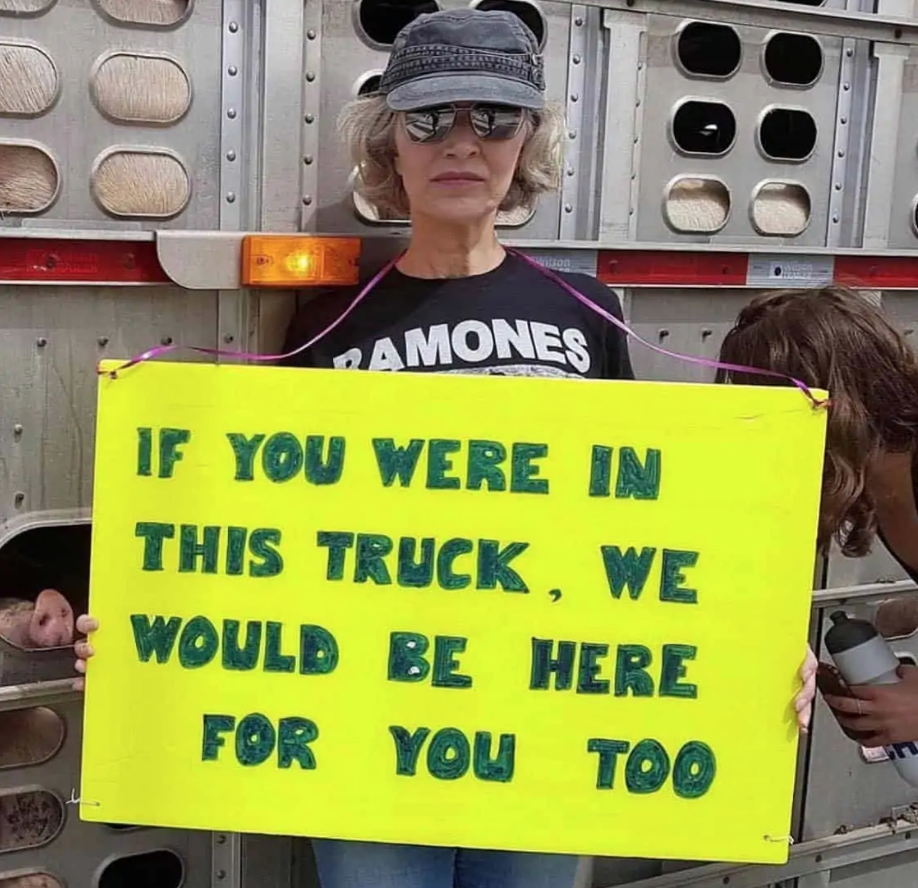
The 28-year-old male trucker who killed Regan walked away with a $400 fine and a careless driving charge – a non-criminal charge under the Highway Traffic Act. Regan’s killing sheds light on an unregulated industry, subsidized by governments and propped up by institutions who only care about the bottom line.
Regan was one of few people fighting against a powerful industry. For years she was a voice for the voiceless and fought against oppression in all aspects of her life.
At a vigil, Regan’s father, Bill Russell, said “My daughter changed my life. I taught her in grade 7 and 8, and in later life, I became the pupil. She is the greatest teacher I’ve ever had.”
At the height of the pandemic, and a historic heat wave, Regan spent her final moments providing water and comfort to pigs who had never received compassion in their short lives.
Today, we honour Regan Russell who committed her whole self to ending the mass exploitation of sentient beings.
In honour of Regan, I challenge everyone to bear witness in whatever way they can: watch Dominion, attend a vigil, meet up with an Animal Save chapter in your area. If you want to support Regan in other ways, you can donate to the Regan Russell fundraiser that will help fund Ontario sanctuaries here. Above all, the best thing we can do for Regan – and for the animals – is to go vegan.

